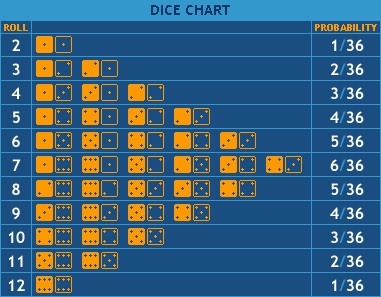The simplest and the easiest basic craps strategy for a beginner player is to learn the rules of the game and the types of bets, and make good use of them. There are many types of bets that a player can place during the game, however, the different types of bets have different casino odds. As a beginner, there are only a few bets you need to know about when learning to play craps. The most common bet on the craps table is the Pass Line bet. It is on the outside of the table and creates a somewhat border around the layout. This bet is saying that the dice are going to “pass”, meaning win.
Craps might seem like one of the most intimidating games in the casino. The chips fly in every direction. Players bark bets–often in a language of their own–at the dealers. It’s fast and overwhelming for a beginner. And the roars. Who can miss the roars?
So how do you play craps? Whether online, or in person, understanding the rules and basic strategy of this wildly entertaining and exciting table game will quickly transform you from a novice to the one leading the cheers you won’t find anywhere else in the casino.
In this craps 101 rules and strategy primer, we will simplify the complex and varied wagers that can be a lot to digest.
Craps wagers are divided into line bets, single-roll bets and multi-roll bets. So how do you get started?
Line Bets

Line bets are the simplest bets in craps, all paying even money. These bets are the pass, don’t pass, come, and don’t come.
The pass bet is placed before the come-out roll and is rooting for the shooter to win. If a 7 or 11 is rolled on the come-out roll, the pass line wins. If the shooter rolls a 2, 3, or 12 come out, the pass line loses. Once the come-out roll lands on 4, 5, 6, 8, 9 or 10, that number is the point. The pass bet wins if the shooter rolls that same number again before rolling a 7. If the shooter rolls 7 before the point, the pass bet loses.
Scenario 1: You place $10 on the pass line. The shooter rolls 7. You win $10, and you keep the same amount on the pass. The shooter rolls 12, and you lose $10 (now you’re even). You reup $10 on the pass and the shooter rolls 6, which is now the point. The shooter rolls 11, 5, 8 and 3 in consecutive rolls, but you had no action on any of those. The next roll is a 6, so you win $10 on your $10 pass bet.
Once you get the hang of the pass bet, you’re home free, and the game starts to slow down and make sense. Just betting the pass line is enough to get comfortable at the table and relish in the excitement. But of course, there are so many more options.
You can be a “wrong bettor” and wager on the don’t pass line, playing against the shooter (and with the house). The don’t pass bet is the opposite of the pass line, in that if a 7 or 11 rolled on the come-out roll the bet loses, and if a 2, 3, or 12 comes out the bet wins. Once the point is established, the don’t pass wins if 7 is rolled before the point.
Pro tip: Be warned that playing the don’t pass may earn you the evil eye in the casino, as you’re betting against most of the other players at the table.
The come bet is the same thing as playing the pass line, except it is placed after the come-out roll. You’ll basically establish your own point and the rules remain the same–you must roll your point before a 7.
Lastly, you guessed it, the don’t come is the opposite of the come bet. The bettor wagers against the shooter on the don’t come bet.

Single-roll Bets
Single-roll bets are placed at any time, for one turn. Examples of single-roll bets are any craps (2,3, or 12), which pays 7:1, and any 7, which pays 4:1.
Pro tip: Even though any 7 is a wildly popular craps wager, it’s generally considered a sucker bet because of the high house edge, and should probably be avoided.
Another bet in craps is the field where the bettor wagers on the shooter rolling a 2, 3, 4, 9, 10, 11, or 12. Field bets only pay out 4:1 1:1 but include multiple combinations and gives the player better chances of winning.
More specific rolls in craps can yield much higher payouts if the player is ambitions enough.
The yo bet refers to the 11 and pays out 15:1. A new player may be confused when they hear the common cry of C and E, but it simply stands for craps plus 11, effectively two bets in one. An eleven bet pays out at 15:1 and the craps half of the bet pays out 3:1.


Ace-deuce, otherwise known as three craps, is betting on a 3 roll and pays 15:1. Rolling snake eyes (two 1s) or boxcars (two sixes)—the 2 and the 12 bets–each pay 30:1. There’s also a combination bet–the high-low--that pays 15:1 on either 2 or 12.
Last of the single roll bets is the horn which is a combination of the 2, 3, 11 and 12, which pay the same as if you bet them separately.
Pro tip: The most dizzying time at the table is prior to the come-out roll, where many of these single-roll bets are shouted out and chips are tossed. Plays like the horn-high yo (horn bet, plus a little extra on the 11) and the high-low yo (2, 12, 11) prove there’s virtually no limit to the combination of bets you can place.
Multi-roll Bets
Multi-roll bets are wagers that stand until either your number is called, or the shooter rolls 7.
Big 6and Big 8 are very simple. You’re betting that the dealer will roll 6 or 8 (whichever you’re playing) before rolling a 7. It pays 1:1. Hard way bets are placed on the double combination of the dice (for example, 4-4 is hard 8). Hard way 4 and 10 pay at 7:1, and hard way 6 and 8 both pay out at 9:1.
Place betsare placed on any number—4, 5, 6, 8, 9, 10–and their odds differ based on how many combinations can equal the number wagered. Place bets on 6 and 8 pay out at 7:6; the 5 and 9 pay out 7:5; the 4 and 10 pay 9:5.
Summing up
Learning craps can be difficult, but certainly not impossible. Even a novice can get a handle on the game with some effort and repetition starting with the simpler bets and then expanding. Learning and practicing in an online casino is a great way to get comfortable with the rules. Now that you know the basics, go get rolling, and don’t crap out.
Let me begin by apologizing to our beginner craps players. I pride myself on being a good teacher, but I overlooked the fact the I have not yet written an article dedicated to the free odds bet. I took it for granted that everyone understood what is mathematically the best bet in the game.
However, recently, I started seeing very basic questions about the free odds bet pop up on the RoadGambler YouTube channel.

So let’s have a simple discussion about the free odds bet.
For purposes of simplicity, I am only going to discuss free odds on the light side, aka the pass and come side. For the dark side of free odds, see this: https://roadgambler.com/casino/darkside/
Also, the free odds are simply referred to as ‘odds’; so going forward, I will use the term ‘odds’ in lieu of ‘free odds.
WHAT ARE THE FREE ODDS BET?
The odds bet is a bet that can only be made once the player has bet on the pass line or come bet.
It’s mathematically the best bet on the table because the odds pay true odds. That means that, unlike almost every other bet in the casino, the house has no advantage.
Odds bets are usually capped. At most Las Vegas strip properties, the odds bet is capped at a maximum of 3x, 4x, and 5x.
For example, here is a table limit sign at a Las Vegas Strip casino.
Notice that the minimum bet on this table is $15. 3x, 4x, and 5x means that: if the point is 4 or 10, then the maximum odds are 3 times the pass line bet; if the point is 5 or 9, then the maximum odds are 4 times the pass line bet; and if the point is 6 or 8, the maximum odds allowed are 5 times the pass line.
Let’s say that you make a $15 pass line bet. That means that in the above picture since the point is 8 (as marked by the white puck), you can bet $75 worth of odds.
Some casinos will allow more free odds. Notice the sign that says 100x. That means if you bet $5, you can bet up to $500 worth of odds.
WIN-LOSS CONDITIONS OF THE ODDS BET
The odds bet will win if the point assigned to that odds bet rolls before the 7 rolls.
For example, if the point is 8, and the 8 rolls before the 7 rolls, then the odds bet will win. If the 7 rolls before the 8 rolls, then the odds bet will lose.
Odds bets can also be wagered on Come bets after the Come bet point has been established. Be warned that typically if the bettor has a live come bet with odds, and the pass line has just won, then the next roll will be a come out roll for the pass line. In that case, the odds bet attached to the come bet will not be working unless the bettor declares the odds to be working.
HOW TO IDENTIFY AND MAKE THE ODDS BET
Beginner Craps Strategy
In the picture below, the two bets that are behind the pass line bet are the odds bet. To make the odds bet, you just position your chips in the area behind your pass line bet, AFTER THE POINT HAS ROLLED.
If you are playing online, the odds bet is made by dragging chips to the area behind your pass line bet, like this…
PAYOUT ON ODDS BET
Beginner Craps Strategy Guide
The most important thing to know about the odds bet is the payout.
The following are the payouts for each point…
Point is 4 or 10
- Odds will pay 2-1.
- For example, if you bet $10 on the odds, you will be paid $20
Point is 5 or 9
- Odds will pay 3-2.
- For example, if you bet $10 on the odds, you will be paid $15.
- When betting odds on the 5 or 9, always make sure that you bet in even dollar increments. For example, if you bet $5, you will be penalized. True odds payout would be $7.50, but since most casinos do not have 50 cent chips, the casino will round down and pay $7.
Point is 6 or 8
- Odds will pay 6-5.
- For example, if you bet $10 on the odds, you will be paid $12.
- Always bet in $5 increments, or else you will be penalized. The casino will round down from the true odds payout.
FINAL ADVICE
When in doubt about how much to bet, follow this one simple rule about how much to bet on free odds: Bet in $10 increments.
If you bet in $10 increments, you will always have the correct odds bet. Make sure that the $10 increment does not go over the maximum odds allowed.
Play responsibly and enjoy!
Beginner Craps Strategy
Posted in: Casino, Craps, Gambling